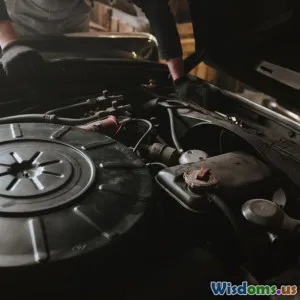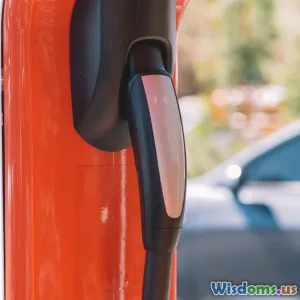
Are Hybrid Cars Really Worth the Investment in 2024
8 min read Exploring whether hybrid cars in 2024 offer true value through cost savings, technology upgrades, and environmental impact. (0 Reviews)
Are Hybrid Cars Really Worth the Investment in 2024?
Introduction
The automotive landscape is rapidly transforming with green technology at its forefront. Among the options gaining traction, hybrid cars stand out as popular contenders promising fuel efficiency and reduced emissions. But as we step into 2024, shoppers face a critical question: Are hybrid cars really worth the investment? With electric vehicles (EVs) flooding the market and gas prices fluctuating, buyers must carefully weigh upfront costs against ongoing expenses and environmental benefits. This article takes an in-depth look at the real value hybrids offer today to help you make an informed decision.
Understanding Hybrid Cars: The Basics
Hybrid vehicles combine an internal combustion engine (ICE) with an electric motor powered by a rechargeable battery. This dual system aims to maximize fuel economy by using electric power during low-speed driving and assistance from the gasoline engine when needed.
Types of Hybrids in 2024
- Full Hybrids: Such as the Toyota Prius, they can run solely on electric power for short distances.
- Mild Hybrids: Use electric motors mainly to assist the gasoline engine, improving efficiency but not driving solely on electric mode. Examples include the Acura MDX Hybrid.
- Plug-in Hybrids (PHEVs): Feature larger batteries and can be plugged in to charge, enabling extended electric-only range like the Ford Escape PHEV.
Each type balances cost, performance, and efficiency differently, influencing their value proposition.
The Economic Case: Cost vs. Savings
Upfront Cost and Incentives
Hybrid models generally come with a higher upfront price than their conventional counterparts due to advanced technology and batteries. For instance, in 2024, a base Toyota Corolla Hybrid starts at around $24,000, roughly $3,500 more than the standard Corolla. Premium hybrids or PHEVs, like the Lexus RX 500h, can command an even steeper premium.
Yet, many governments and states continue to offer incentives:
- Federal Tax Credits: Up to $7,500 for certain PHEVs.
- State Rebates: Regions like California provide additional rebates and carpool lane access.
These incentives can significantly offset the initial cost gap.
Fuel Savings and Maintenance
Fuel economy is the undeniable strength of hybrids. According to the U.S. Department of Energy, a 2024 Toyota Camry Hybrid averages 52 MPG combined, compared to 32 MPG for the gasoline version. For drivers covering 15,000 miles annually, this translates to saving almost 350 gallons of gas — about a $1,200 yearly saving given current fuel prices around $3.40 per gallon.
Hybrids also typically have lower brake wear because regenerative braking reduces mechanical use.
However, battery replacement costs must be considered if the vehicle’s longevity spans beyond warranty periods. Battery warranties commonly last 8-10 years or roughly 100,000 miles, and replacement prices can range around $3,000-$5,000.
Resale Value
Hybrids tend to retain value well in markets focused on fuel economy and environmental impact. According to Kelley Blue Book data, hybrids hold about 10-15% higher resale values than gas-only vehicles after five years, which reinforces their long-term cost efficiency.
Technological Innovations in 2024 Hybrids
In 2024, hybrid technology is more refined and smarter than ever:
- Improved Battery Tech: Lithium-ion batteries with greater energy density allow lighter weight and longer electric ranges.
- Regenerative Braking Efficiency: New systems recover more energy when stopping, enhancing efficiency.
- AI-Driven Power Management: Some hybrids optimize power flow dynamically based on road conditions and driver behavior.
Manufacturers are also integrating hybrid platforms with advanced infotainment and driver assistance features, such as adaptive cruise control and lane-keeping assist, further enhancing user experience.
Environmental Impact: Real vs. Perceived
Hybrids undeniably reduce greenhouse gas emissions compared to pure ICE vehicles. Multiple studies estimate hybrids emit 25-35% less CO2 on average — a meaningful environmental contribution especially for urban commuting.
However, critics argue that hybrids still rely on fossil fuels and their battery production involves mining that impacts ecosystems. Yet, compared to conventional vehicles:
- Hybrids consume less fuel over their lifecycle.
- Lower tailpipe emissions improve city air quality.
Plug-in hybrids offer an even greener option when drivers regularly recharge and use electric-only modes for daily short trips.
Real-World Performance and Consumer Experience
2024 hybrid owners report:
- Smooth and quiet rides, particularly in electric-only modes.
- Reliable cold-weather performance, overcoming past battery limitations.
- Cost savings on regular commutes, reducing 'range anxiety' seen in some EVs.
Some downsides noted include:
- Slightly reduced trunk space due to batteries, such as in Toyota RAV4 Hybrid.
- Additional weight sometimes diminishes sporty handling.
Nonetheless, hybrids strike a good balance between practicality and conscience-driven choices.
Conclusion: Is a Hybrid Car Worth It in 2024?
In 2024, hybrid cars represent a compelling middle ground between gasoline vehicles and fully electric cars. Buyers seeking to reduce fuel expenses, lessen carbon footprints, and maintain driving ranges without compromise find hybrids an attractive proposition.
Though initial costs are higher, government incentives, lower fuel consumption, and strong resale values help justify the investment. Technological strides continue to enhance driving pleasure and efficiency.
Ultimately, the worth of purchasing a hybrid depends on individual needs:
- If your driving involves long distances with limited charging, hybrids save money and stress.
- For mostly urban drivers with access to charging, plug-in hybrids or EVs might offer better returns.
As hybrids evolve, they remain a smart investment for eco-conscious consumers wanting practical, innovative, and financially savvy vehicles in 2024’s dynamic automotive market.
Sources:
- U.S. Department of Energy, Fuel Economy Data
- Kelley Blue Book, 2024 Residual Value Reports
- Environmental Protection Agency (EPA) Emissions Studies
- Manufacturer websites and latest model pricing
Rate the Post
User Reviews
Popular Posts




















